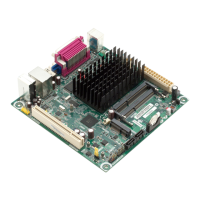Technical Reference
59
2.7 Power Consumption
Power measurements were performed to determine bare minimum and likely
maximum power requirements from the board, as well as attached devices, in order to
facilitate power supply rating estimates for specific system configurations.
2.7.1 Minimum Load Configuration
Minimum load refers to the power demand placed on the power supply when using a
bare system configuration with minimal power requirement conditions. Minimum load
configuration test results are shown in Table 29. The test configuration was defined as
follows:
• 2 GB DDR3/800 MHz SO-DIMM
• USB keyboard and mouse
• LAN linked at 1000 Mb/s
• DOS booted via network (PXE); system at idle
• All on board peripherals enabled (serial, parallel, audio, …)
Table 29. Minimum Load Configuration Current and Power Results
3.3 V 5 V 12 V1 12 V2 -12 V 5 VSB
0.45 A 2.2 A 0.4 A 0.143 A 0.03 A 0.13 A
2.7.2 Maximum Load Configuration
Maximum load refers to the incremental power demands placed on the power supply,
augmenting the minimum load configuration into a fully-featured system that stresses
power consumption from all subsystems. Maximum load configuration test results are
shown in Table 30. The test configuration was defined as follows:
• 4 GB DDR3/800 MHz SO-DIMM
• 14.1-inch LCD via LVDS (D525MWV only)
• SATA DVD-R/W
Load: DVD playback
• 3.5-inch SATA hard disk drive, running Microsoft Windows Vista Home Basic
Load: continuous read/write benchmark
• 2.5-inch SATA hard disk drive
Load: continuous read/write benchmark
• Intel Z-U130 USB Solid-State Drive or compatible device on the USB flash drive
header
Load: continuous read/write benchmark
• Wireless card on PCI Express x1 Mini Card slot, connected via 802.11n protocol
Load: continuous read/write benchmark on remote share
• Riser card on conventional PCI slot, populated with PCI LAN card, running file
transfer through local network to SATA hard drive
• USB keyboard and mouse

